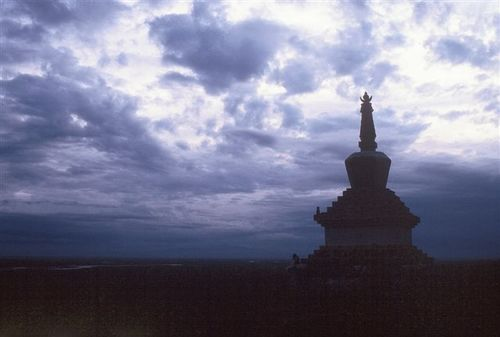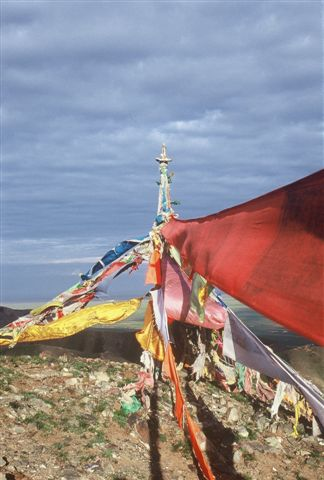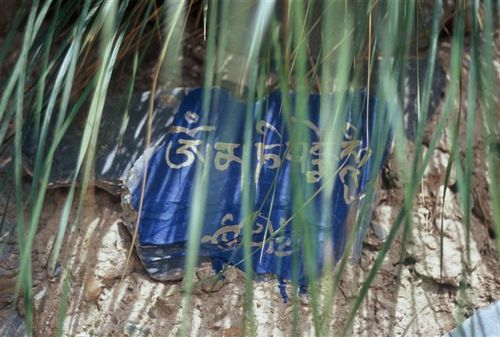The Ultimate Journey
A Trip to the Heart of Tibet
Article and photos by Matthew Bowden

Tibetan Stupa.
The snow-capped mountains rise majestically from the valley floor. Far below, an insignificant tarmac trail meanders alongside a shallow, rocky river. The Sichuan — Tibet Highway is an ambitious name for such a tiny road that can barely handle two cars running next to each other and is studded with potholes and random piles of rubble. But the road is just the means to an end, with that end being the sea of nature where travelers on the highway find themselves floating. The snowy crests of mighty Himalayan waves were balanced by the cool green of the valley below. It is a veritable feast for the eyes and a banquet for the soul.
Our bus rattled steadily along the road, its interior a cloud of cheap cigarette smoke and a patchwork of strange smells. Buckets of live fish splashed and sloshed with every pothole, soaking my knees and legs. In contrast, the Buddhist monks to whom the fish belonged quietly admired the scenery or concentrated on subduing the feeling of motion sickness.
I looked around at my neighbors and wondered what the reasons behind each of their journeys could be. Were they, like me, here because some guidebook particularly recommended a visit to our destination? Were they returning home after a long absence? Were they on a pilgrimage? Or were they crazed adrenalin junkies, along for the bone-rattling and often hair-raising ride afforded by the road? The reasons were insignificant. After all, we were all on the same bus, breathing in the same smoke-tinted air. We had all paid the same price for a ticket (except perhaps the monks), and each bump in the road shook our bodies equally without discrimination. United by circumstance, we continued.
This was traveling. In China, thousands of miles from the Great Wall and Forbidden City and hundreds of miles from the cut-throat economic development of the country's pulsating metropolises. In the world's most populous nation, our bus was trundling through a pristine mountain wilderness, untouched by the human desire to control the elements. No Three Gorges Dam was to be found here. No Grand Canal diverting nature's preferred course. The Tibetans are people irresistibly at one with their environment. Their centuries-old homes in western Sichuan Province, at 3000 meters altitude, are quite literally castles in the sky. Huge yet discreet buildings, perfectly adapted to their location and sturdily built to last using the massive rocks quarried nearby. Castles: defenses against enemies, against wolves, against the howling, freezing winds.
Time and time again, as we passed an awe-inspiring view in what we thought was an uninhabited place, a shrine would flicker past our eyes, a colorful blur of prayer flags and slates inscribed with prayers as if confirming to us that the view was worth celebrating, that we should be thankful for such stunning beauty. Upon reaching the summit of a lofty mountain pass, tiny square prayer tickets would be flung from the bus windows and sent flying in a cloud of color. This was a touching, if slightly worrying, tribute to the fact that nature had allowed us safe passage in an act of gracious compassion.

Tibetan prayer flags.

Tibetan prayer painted on slate.
Twelve hours after commencing its epic journey, the bus came to a creaking halt in Ganzi, our destination, and a welcome sight for travel-weary eyes. Despite being small, the town, the largest settlement for hundreds of miles around, is a fascinating mess of people, architecture, and nature. A staging post on the road to Tibet, a market town, and a center of government all rolled into one makes walking along the town's main thoroughfare a remarkable experience.
Local Tibetans and Khamba ride past on their twenty-first-century horses — motorbikes decorated with red and yellow ribbons adorning the handlebars. Monks stroll by, elegant and serene, in crimson robes and yellow, crescent-shaped hats resembling giant banana splits. Han Chinese women strut in tight jeans, high-heeled shoes, and fashionable coats. Bright-eyed, brown-faced Tibetan traders laugh and tout their wares, which include beautiful daggers and finely crafted prayer wheels. Meanwhile, they all stare with keen interest at the overwhelmed foreigner, who sticks out like a sore thumb in his Goretex jacket and walking boots, camera in hand, attempting to capture forever some of the magic of that moment.
Ganzi's old town stands on the slopes of a hill that overlooks the new town and the wide river valley just beyond. The mud-walled buildings huddle together as if for shelter against the harsh weather, resulting in a maze of narrow alleyways leading upwards towards the temple at the top of the slope. We went there. Smoke from coal fires filled the air, while the heart-warming sounds of giggling, rosy-cheeked, runny-nosed Tibetan children played like music to the ears as they chased after us before suddenly stopping to hide behind a wall, watching with interest and amusement these odd newcomers to their neighborhood.
The maze of alleyways eventually got the better of us, and while we could see the temple, the path to it proved elusive. Luckily, two local Tibetan girls came to our rescue. They were resplendent in their traditional robes, hair braided and intertwined with red threads, and marvelous silver earrings dangling gracefully from their ears. With the surefootedness and intricate knowledge that only a local could have, they soon brought us to the front of the temple.
The temple was a hive of activity, awash with color, flooded with incredible thangkas (Tibetan religious paintings) depicting the Buddha, Gods of Destruction, Creation, and Compassion, and filled with golden statues, some small, some gigantic, of the Buddha and his disciples. In one room, we encountered a group of meditating monks reciting a sutra with a musical accompaniment of sacred horns and cymbals. The pungent smell of yak butter candles, the enchanting sounds of the music, and the stunning aesthetic beauty and mysterious symbolism of the thangkas combined to overwhelm my senses.
As we left one of the temple buildings, we came upon a large outdoor terrace overlooking Ganzi, offering incredible views of the whole valley. It was a scene to exhilarate, stun, and awaken the soul. A group of 50 young monks were dancing, their robes floating and swirling through the air, their steps timed to the beat of drums. Lost in a blur of arms and crimson cloth, the monks danced, turned, swayed, and circled round and round, with happiness radiating from their smiling faces. Behind the spectacle in the distance rose the blinding white peaks of the Chola Mountains, dazzling 4-mile-high giants. At the same time, the cloudless blue sky above played host to the majestic flight of eagles.
In that breathtakingly beautiful and intense moment, everything made sense. I was not a traveler, an outsider, or a foreigner; the monks were not Tibetans or strange and exotic dancers. We just were. We were all connected and participating, one way or another, in this same heart-stopping unforgettable instant, all part of nature's grand scheme, and profoundly appreciative of her richness and might. Something, even if for only a fleeting second or two, united everyone present. It is for events and feelings like those that people will travel to the ends of the earth. Once we experience that moment, that feeling of sheer joy and delight and realization of the magic of life stays imprinted in our memory like a fantastic scar: the ultimate photograph.
Matthew Bowden graduated from SOAS, University of London, with a first-class degree in Chinese and Politics. He currently lives in Xiamen, China, attempting to capture some of that country's upheavals in writing while maintaining a permanent sun tan. He supplements his paltry income by providing various publications with freelance articles. |
